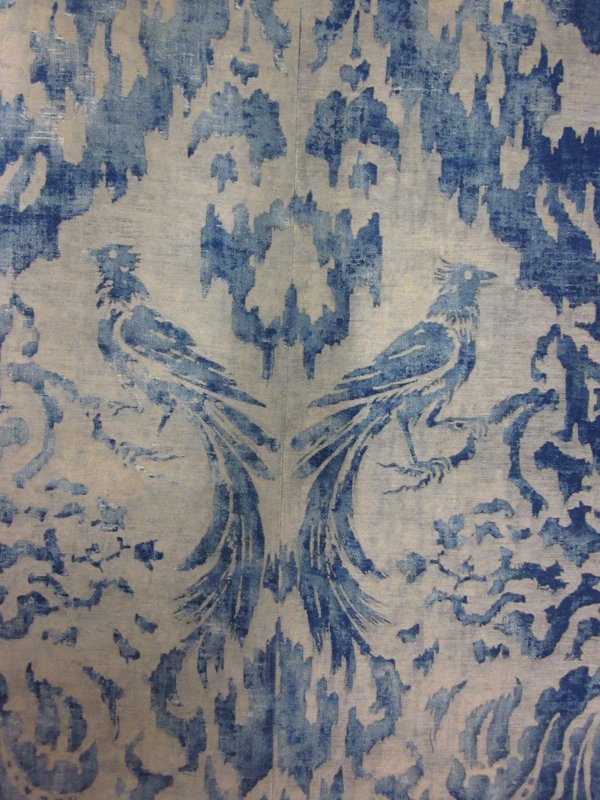"Many a room has been "made" by a single panel of Fortuny fabric. As furniture coverings and curtains these prints are infinitely rich and adaptable. And the superb gesture is to hang entire wall surfaces with Fortuny stuffs."1
 Textile panel detail
Textile panel detail
Mariano Fortuny
c. 1915
Gift of the Henry Morrison Flagler Museum
87.1010.1
Mariano Fortuny's interest in the past influenced all of his work. His most iconic garment, the finely pleated silk Delphos dress, was based on the pleated garments portrayed in ancient Greek sculpture. To complement the Delphos, Fortuny created loose-fitting coats, capes and wraps and patterned with rich designs. Fortuny's tastes were varied and his textile patterns referenced a wide array of artistic traditions. The Italian Renaissance was a consistent inspiration, but Fortuny also borrowed design elements from sources as diverse as the pre-Columbian art of Central and South America, Chinese brush paintings, Coptic textile designs, and Arabic calligraphy. Fortuny's first encounters with historic textiles were through his family. His parents collected historic textiles, and Fortuny continued this collecting tradition, amassing a large collection of historic textiles that were kept in trunks at the Palazzo Orfei, Fortuny's home in Venice.
Fortuny's historically-informed textile designs graced his timeless garments, but they also embellished living spaces. In 1921 or 1922, about 15 years after designing the first Delphos dress, Fortuny opened a small textile factory geared to the production of home furnishing textiles. Unlike his garments, which were usually made from silk velvet, crepe or lightweight silk chiffon, Fortuny's interior textiles were made from durable cotton. Still, the interior textiles featured the rich patterns and luminous colors that distinguished Fortuny's printed velvet and silk garments.
As the opening quote suggests, Fortuny's interior textiles were well received, and soon graced homes and luxury hotels in Europe and North America. The blue patterned textile seen above is a detail from a panel that once graced the walls of townhouse on New York's Fifth Avenue. Despite their rich pedigree, Fortuny's cotton interior textiles were considered somewhat affordable. A 1927 Vogue article titled Economy in Decoration described the appeal of Fortuny's textiles: "even at close range they give all the feeling, as well as the colour charm, of those wonderful old damasks that one would love to own and can't afford."2 According to the article, Fortuny fabrics ranged from $5 a yard to just under $3 a yard. In today's dollars, that is about $65 to $40 a yard.
 Textile
Textile
Mariano Fortuny
late 1920s
Gift of Nancy Riegelman
2003.602.2
This textile features the metallic pigment that Fortuny often used in his textile designs. Though this image doesn't quite do the colors justice, the ground is a peachy-orange and the design of grape leaves, bunches and vines is stamped in a light metallic gold. Fortuny's textiles rarely featured a solid, unvarying background. Instead, natural dyes were layered, brushed or sponged onto the fabric, creating a base color with depth and variation. Metallic pigments added richness to the designs, and were a hallmark of both his garment and interior textiles. Early patterns were block-printed, though Fortuny later developed a printing process that allowed him to produce interior textiles in volume.
Fortuny passed away in 1949, but his interior textiles are still produced at the original Venetian factory. Contemporary Fortuny textiles are based on Fortuny's original designs and new patterns designed in the spirit of Fortuny. The current owners (not related to Fortuny) are very aware of Fortuny's legacy and reputation. Visit the Fortuny website here.
1 “Advertisement.” New York Times. 20 Feb. 1931: 8.
2 "Economy In Decoration" Vogue 15 May 1927: 134.


Wow very nice textile!